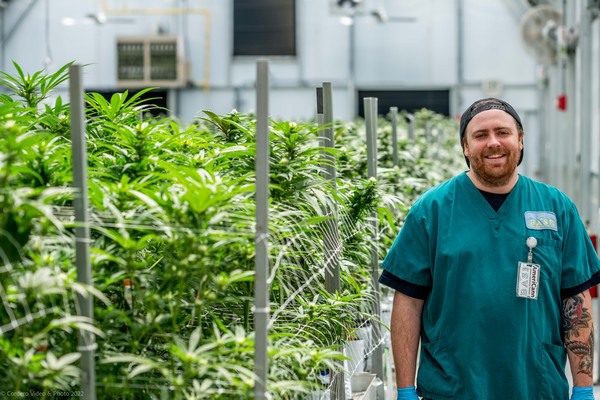A boom, a mega collapse and slow recovery. The cannabis industry has been through a lot over the last years. This doesn't keep our editorial team from www.mmjdaily.com from writing articles on everything that is relevant for growers of medicinal cannabis. Please find 10 of their most interesting articles here.

Moving from chemicals to living soil: “The quality is second to none”
"The more research I did, the more I learned about the disadvantages of high salt fertilizers and the benefits of growing organically. We decided to switch from growing hydroponically to growing in living soil," says Mitch Hoesing, Director of Cultivation at Fuze Extracts. "There is a stigma surrounding growing organically, as most people seem to think that it produces better quality but not as much yield. Yet that is not the case at all. You can definitely get the same yields if you do it correctly and learn how to balance your soil."

“There is a lack of standardization, compliance and education in American cannabis facilities”
In college to be a nurse, Kayla Sanchez changed her route by joining a cannabis program, where she discovered her love for cannabis and its science. Today, she is the CEO of the new company Guided Green Solutions, providing education and training in cannabis standard procedures and crop science. “I realized there was a need for standardization, compliance, and education in American cannabis companies. If people start working without the proper knowledge beforehand, there is a lot of room for error,” Kayla says. “Currently, safety for the grower is a missing link in the American cannabis industry.”

CAN: “Our facility expansion increased our production to 85,000 kgs of cannabis”
“There have been a lot of Canadian producers that only focus on selling premium flower. But the truth is that people are looking for the best quality product at the right price. In a high inflationary market, you have to be able to provide consumers with what they are looking for,” says Beena Goldenberg, CEO of Organigram. The Canadian cannabis company recently reported record first-quarter fiscal results. According to Beena, maintaining success in today’s market starts off on the top line, by understanding what the consumer is looking for. At the same time, when it comes to their bottom line, it’s all about getting their cultivation costs down to improve their margins. “In order to do so, we recently finished our facility expansion and increased our yield per plant by 30%.”
“Cannabis propagators should consider retipping to expand their liner production”
“There are limitations when relying on mother stock plants and stem cuttings for propagation, as they can accumulate pathogens and lose vigor over time. Therefore, there is interest in the micropropagation of cannabis for the production of uniform, vigorous and pathogen-free clones. However, hyperhydricity, culture decline, and poor ex vitro rooting have limited the availability of micropropagated liner plants.” A recent study done by the University of Connecticut explored the process of retipping, which is the repeated harvesting of new shoots from recently micropropagated plants that are then stuck as cuttings called retips. “Retipping can enhance output from the micropropagation process while still producing clonal, uniform liner plants.”
US (MA): “Moving from an indoor grow to a greenhouse facility dramatically reduced our utility costs”
"Our greenhouse facility is about ten times the size as our previous indoor grow and costs roughly the same to operate." From full environmental control to supplemental lighting, automated drip irrigation, and under-bench heating systems. That is just some of the technology that Bask uses to achieve the best growing practices in their greenhouses in Massachusetts. Christian Powers is the Director of Cultivation at Bask and explains that the company started out growing indoors. "We moved from our indoor grow to our greenhouse facility back in February of 2020, following our own research into existing cannabis markets such as Washington and Colorado. We noticed that the prices were dropping consistently as markets started to mature and knew we needed to think forward about the longevity of our company." Moving to a greenhouse and utilizing natural resources like the sun, allowed Bask to provide the same quality of flower, while reducing operating costs, being more sustainable, and environmentally conscious.

Capacity reached in 3 days: “There is an insane demand for risk-free cannabis clones”
“Had we known the demand would be to this extent, we would have directed ourselves to a larger capacity. Now, we’ve already expanded our facility and are hoping to add a new one in the near future,” says Ray Thek, Co-Founder of Quill Labs. The new company has only been operational for four months and has already been overwhelmed by the demand. “Many cannabis growers have previously not had proper access to outsourced, clean, non-black market clones.” Now, Quill Labs offers phenohunted, high-quality clones from a range of popular strains to licensed growers. “We want to help the industry by making outsourced clones and phenohunting more accessible.”
Moving away from 12:12: The effect of different photoperiods on medicinal cannabis
"The standard practice to initiate flowering in medicinal cannabis involves reducing the photoperiod from a long-day period to an equal duration cycle of 12 h light (12L)/12 h dark (12D). The fact that this blanket rule is assumed to be optimal for all varieties is quite remarkable considering the diverse latitudinal origins of cannabis and known variation in photoperiod-dependent and -independent (a.k.a auto flower trait) flowering time control in cannabis." In a recent study, researchers sought to identify the effect of nine different flowering photoperiod treatments on the biomass yield and cannabinoid concentration of three medicinal cannabis varieties. "The results show that the assumption that a 12L:12D photoperiod is optimal for all lines is incorrect. In some lines, yields can be greatly increased by a lengthened light period during flowering."

Dutch growers choose North Macedonia: “Lowest labor costs of any medical cannabis producing country in Europe”
When a small group in Holland wanted to start a medical cannabis company in 2016, the location was the final dealmaker. “We were first looking at opportunities in the United States, but some of our investors didn’t want to take any risks being in a country where cannabis is not federally legal. Looking to do something in a country where cannabis is 100% legal, we turned to Europe. One of the first countries to legalize medical cannabis cultivation in Europe was North Macedonia. It’s an agricultural country that has the lowest labor costs of any medical cannabis-producing country over here,” explains Stephen Malloy, CEO of PharmaRolly Holdings B.V. The Dutch company has been producing medical cannabis in North Macedonia since 2019.

Technology allows cannabis growers to test potency in-house, in less than a minute
"If growers can do their testing in-house, they can improve their production process and save money," says Ruben Valenzuela, Founder and Chief Technology Officer of Valenveras. That is why Valenveras, after years of research, has developed a 'portable lab' for cannabis analysis that uses NIR technology. "NIR spectroscopy is a fast, non-destructive technique that allows the measurement of multiple components in a sample in a matter of seconds. It is a non-invasive technique that does not require sample preparation, making it ideal for the analysis of delicate or expensive samples. We now have a handheld device available that measures cannabis potency accurately in less than a minute, allowing companies to make fast and accurate decisions to improve their business."

"Over 200% in small fan leaves"
"CBDA synthases engineered into hemp show over 300% more CBDA/THCA in early flowers"
Hypercann Agrogenetics announced that its licensed engineered Cannabidiolic acid (CBDA) synthases have, for the first time, been transformed into hemp to boost levels of CBDA and THCA in leaves by over 200% and early flowers by over 300%.

